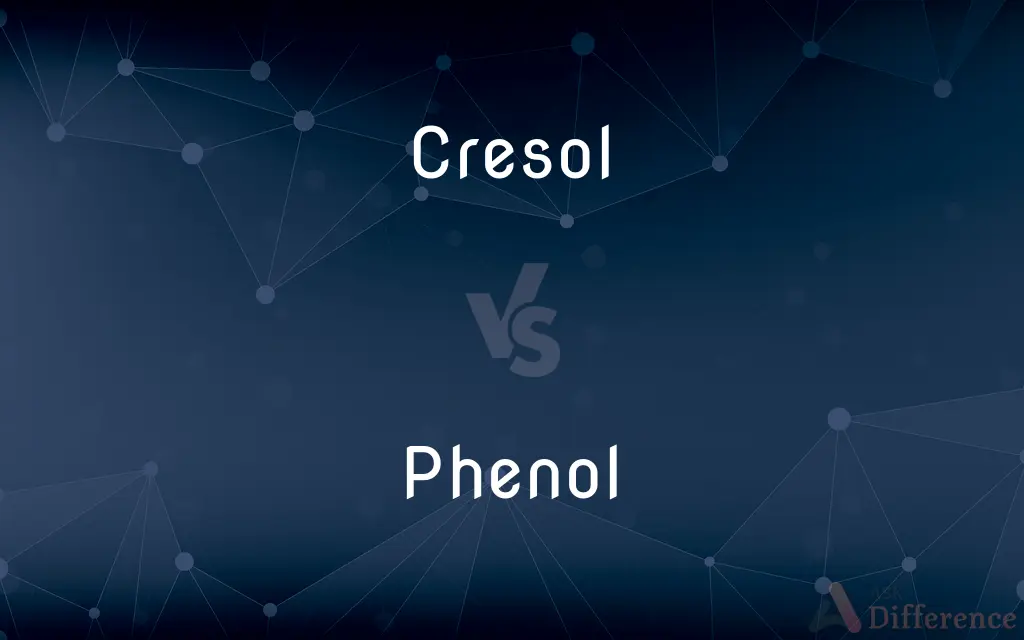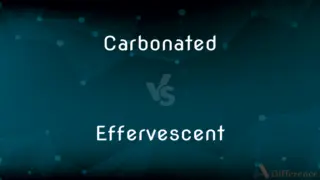Cresol vs. Phenol — What's the Difference?
By Tayyaba Rehman — Updated on September 27, 2023
Cresol is a compound with a methyl group added to phenol; Phenol is an aromatic compound, a white crystalline solid, used as a disinfectant and in chemical synthesis.

Difference Between Cresol and Phenol
Table of Contents
ADVERTISEMENT
Key Differences
Cresol is a type of phenolic compound, classified as a methylphenol. It is essentially phenol with an additional methyl group. Cresols exist in three isomeric forms: ortho-cresol, meta-cresol, and para-cresol. Each isomer has a different arrangement of the methyl group relative to the hydroxyl group on the benzene ring. Cresols are used in the production of antioxidants, resins, and other chemicals due to their stability and solubility properties.
In contrast, Phenol is a basic aromatic compound, consisting of a benzene ring bonded to a hydroxyl group. It is a white crystalline solid at room temperature and has a distinctive sweet and tarry odor. Phenol is known for its antiseptic properties and is utilized in the synthesis of plastics, resins, and pharmaceuticals. It is considered the parent compound of cresols.
Cresol, due to the presence of the methyl group, has varied chemical properties and uses when compared to phenol. Cresols are generally less acidic than phenol and exhibit higher resistance to oxidation. They find application in the formulation of disinfectants and deodorizers due to their microbial activity and are crucial components in the coal tar from which they are usually derived.
Phenol, meanwhile, is fundamental in chemical synthesis, forming the basis for producing phenolic resins, bisphenol A, and many pharmaceutical drugs. It is considered more toxic compared to cresols, and exposure to high concentrations can lead to severe health effects. The importance of phenol in chemistry and manufacturing is extensive, often serving as a precursor to complex chemical compounds and polymers.
Comparison Chart
Chemical Structure
Methylphenol with three isomeric forms
Basic aromatic compound with a hydroxyl group
ADVERTISEMENT
Acidity
Generally less acidic than phenol
More acidic compared to cresol
Applications
Disinfectants, deodorizers, antioxidants
Plastics, resins, pharmaceuticals synthesis
Toxicity
Less toxic compared to phenol
More toxic, exposure can lead to severe health effects
Source
Derived mainly from coal tar
Found in small amounts in coal tar and other sources
Compare with Definitions
Cresol
It serves as a crucial component in coal tar.
Cresol’s presence in coal tar is significant for various chemical productions.
Phenol
It is a white crystalline solid with antiseptic properties.
Phenol is often used as a disinfectant in healthcare settings.
Cresol
It is used in producing antioxidants and resins.
The manufacturing of certain resins involves the use of cresol.
Phenol
It serves as a precursor for synthesizing plastics and resins.
The production of many plastics involves the use of phenol.
Cresol
It is a methylphenol compound existing in three isomeric forms.
Cresol is used as a disinfectant due to its antimicrobial properties.
Phenol
It is used in the synthesis of many pharmaceutical drugs.
Various medications are developed using phenol in their synthesis.
Cresol
It is less acidic compared to phenol.
The acidity level of cresol is usually lower, making it suitable for specific applications.
Phenol
It is a basic aromatic compound consisting of a benzene ring bonded to a hydroxyl group.
Phenol’s chemical structure makes it fundamental in organic chemistry.
Cresol
It exhibits higher resistance to oxidation.
Due to its resistance to oxidation, cresol is valuable in chemical synthesis.
Phenol
Phenol (also called carbolic acid) is an aromatic organic compound with the molecular formula C6H5OH. It is a white crystalline solid that is volatile. The molecule consists of a phenyl group (−C6H5) bonded to a hydroxy group (−OH).
Cresol
Cresols (also hydroxytoluene) are a group of aromatic organic compounds. They are widely-occurring phenols (sometimes called phenolics) which may be either natural or manufactured.
Phenol
A mildly acidic toxic white crystalline solid obtained from coal tar and used in chemical manufacture, and in dilute form (under the name carbolic) as a disinfectant.
Cresol
Any of three isomeric phenols, C7H8O, used in resins and as a disinfectant.
Phenol
A caustic, poisonous, white crystalline compound, C6H6O, derived from benzene and used in resins, plastics, and pharmaceuticals and in dilute form as a disinfectant. Also called carbolic acid.
Cresol
(chemistry) Any of the three isomeric phenols derived from toluene: ortho-, meta- or para-methylphenol.
Phenol
Any of a class of aromatic organic compounds having at least one hydroxyl group attached directly to the benzene ring.
Cresol
Any one of three metameric substances, CH3.C6H4.OH, homologous with and resembling phenol. They are obtained from coal tar and wood tar, and are colorless, oily liquids or solids. [Called also cresylic acid.]
Phenol
A caustic, poisonous, white crystalline compound, C6H5OH, derived from benzene and used in resins, plastics, and pharmaceuticals and in dilute form as a disinfectant and antiseptic; once called carbolic acid
Cresol
Any of three poisonous colorless isomeric phenols; derived from coal or wood tar; used as a disinfectant
Phenol
Any of a class of aromatic organic compounds having at least one hydroxyl group attached directly to the benzene ring (or other aromatic ring)
Phenol
A white or pinkish crystalline substance, C6H5OH, produced by the destructive distillation of many organic bodies, as wood, coal, etc., and obtained from the heavy oil from coal tar.
Phenol
Any one of the series of hydroxyl derivatives of which phenol proper is the type.
Phenol
Any of a class of weakly acidic organic compounds; molecule contains one or more hydroxyl groups
Phenol
A toxic white soluble crystalline acidic derivative of benzene; used in manufacturing and as a disinfectant and antiseptic; poisonous if taken internally
Phenol
It is more toxic compared to cresol.
Proper handling of phenol is crucial due to its high toxicity.
Common Curiosities
Are Cresols derived from Phenol?
Yes, cresols can be considered derivatives of phenol with an additional methyl group.
How is Cresol different from Phenol?
Cresol has a methyl group added to phenol and is generally less acidic and less toxic compared to phenol.
Is Phenol used in making plastics?
Yes, phenol is fundamental in synthesizing various plastics.
Can exposure to Phenol lead to severe health effects?
Yes, exposure to high concentrations of phenol can lead to severe health effects.
What is Cresol?
Cresol is a methylphenol compound with three isomeric forms used in disinfectants and chemical synthesis.
Is Phenol more toxic than Cresol?
Yes, phenol is generally more toxic compared to cresol.
Can Cresol be used in making resins?
Yes, cresol is used in producing various resins and antioxidants.
Is Phenol found in coal tar?
Yes, phenol is found in small amounts in coal tar.
Can Phenol be used in pharmaceutical synthesis?
Yes, phenol is used as a precursor in the synthesis of many pharmaceutical drugs.
Is Cresol a component in coal tar?
Yes, cresol is a significant component found in coal tar.
What is Phenol?
Phenol is a basic aromatic compound used as a disinfectant and precursor in chemical synthesis.
Are Cresols less acidic than Phenol?
Generally, cresols are less acidic than phenol.
Can Cresol serve as a disinfectant?
Yes, due to its antimicrobial properties, cresol is used as a disinfectant.
Is Cresol resistant to oxidation?
Cresol exhibits higher resistance to oxidation compared to phenol.
Is Phenol a white crystalline solid?
Yes, phenol is a white crystalline solid with a distinctive sweet and tarry odor.
Share Your Discovery

Previous Comparison
Carbonated vs. Effervescent
Next Comparison
Hunt vs. QuarryAuthor Spotlight
Written by
Tayyaba RehmanTayyaba Rehman is a distinguished writer, currently serving as a primary contributor to askdifference.com. As a researcher in semantics and etymology, Tayyaba's passion for the complexity of languages and their distinctions has found a perfect home on the platform. Tayyaba delves into the intricacies of language, distinguishing between commonly confused words and phrases, thereby providing clarity for readers worldwide.
















































